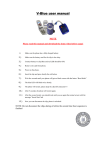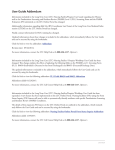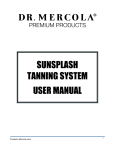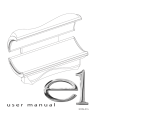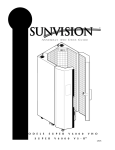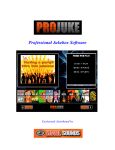Download Section II - Texas Department of State Health Services
Transcript
Tanning Facility Compliance Assistance Packet, Section II Page 1 TEXAS DEPARTMENT OF STATE HEALTH SERVICES DRUGS AND MEDICAL DEVICES GROUP Section II--Test Your Knowledge! The following questions were developed from the “Rules for Licensure of Tanning Facilities” (the Rules). A Tanning facility operator (see section 229.353 (b) of the tanning rules) should be able to obtain a “good” score on this test. To help you understand the importance of specific requirements, the following questions have been marked with symbols to identify possible safety issues and requirements, that if not complied with, could result in the detention of a tanning device. Z=Possible safety issue „=Issue that could result in the detention of a tanning device MULTIPLE CHOICE: „Z 1. The operator must not allow a customer to tan without: 9A. Tanning lotion 9B. Protective eyewear 9C. An electric fan 9D. Bright lighting in the tanning room For answer see section 229.352(a) „Z 2. Who must provide FDA approved protective eyewear? 9A. The customer 9B. The Department of State Health Services 9C. The tanning facility 9D. None of the above For answer see section 229.352(a), (b), and (c) „Z 3. If a customer tanned at 3:00 p.m. today, what is the earliest time they can tan tomorrow? 9A. 11:00 a.m. 9B. 6:00 a.m. 9C. 3:00 p.m. 9D. None of the above For answer see section 229.354(c) (2) DMDG-111 (Revised 11/2008) Tanning Facility Compliance Assistance Packet, Section II Page 2 Z 4. The tanning facility operator must give each customer a written statement containing six specific warnings. Which pair of statements includes two of the six required warnings? 9A. 1. Overexposure to ultraviolet light causes burns 2. Pregnant women should consult their physicians before using a tanning device 9B. 1. Repeated exposure may result in immature aging of the skin 2. Protective eyewear must be worn while tanning 9C. 1. The tanning device must be sanitized once a day 2. When a tanning device is in use by an individual, no other person shall be allowed to remain in the tanning device area 9D. 1. The consumer contact surfaces are not to exceed 115 degrees Fahrenheit 2. Failure to use the eye protection provided to the customer by the tanning facility may result in permanent damage to the eyes For answer see section 229.354(a) Z 5. Who sets and controls the customer’s length of exposure (tanning time)? 9A. The Department of State Health Services 9B. The tanning facility operator 9C. The customer 9D. None of the For answer see section 229.351(c) above Z 6. Which of the following must be used by the tanning facility operator to determine a safe exposure time (tanning time) for a customer? 9A. The maximum exposure time for the tanning device (manufacturer’s recommended time) 9B. The tanning device’s exposure schedule (manufacturer’s recommended time) 9C. The customer’s skin type 9D. All of the above For answer see 229.351(c) „Z 7. Which of the following best describes the maximum timer interval (maximum time to which the timer can be set) for a tanning device? 9A. 30 minutes 9B. Varies with the customer’s tanning history 9C. The manufacturer’s maximum recommended exposure time 9D. The maximum time for the timers that are sold in your area For answer see 229.351(b) Z 8. Which warning signs must be posted in a tanning facility? 9A. One that can be seen from the exterior of the building and one in each tanning room, in a location visible to a person about to use the tanning device 9B. One that can be seen from the exterior or the building and one in a location that is visible to a person entering the tanning facility 9C. One visible to a person entering the tanning facility and one in each tanning room, in a location visible to a person about to use the tanning device 9D. One sign that can be seen from the exterior of the building, one in an entryway, and one in each of the tanning facility’s tanning room For answer see 229.350(a) and (b) DMDG-111 (Revised 11/2008) Tanning Facility Compliance Assistance Packet, Section II Page 3 „ 9. Each tanning device must have a _____ that overrides the timer on the tanning device itself. 9A. Remote timer 9B. 30 minutes timer 9C. Emergency cut-off switch 9D. Answers A and C For answer see 229.351 ARE THE FOLLOWING STATEMENTS TRUE OR FALSE? Z Z Z Z „Z „Z Z Z „Z „Z Z Z „Z Z 1. Customers are required to use a pair of protective eyewear when tanning. 2. A tanning facility must have a written incident log documenting all alleged injuries or complaints involving a tanning device. 3. Once they are in the tanning room, customers are free to set their own ultraviolet exposure interval, regardless of the exposure length determined by the tanning facility operator. 4. Operator training must be documented. 5. It is okay to have lamps in your tanning device(s) that are different than those recommended by the manufacturer as long as they are equivalent to the manufacturer’s recommended lamps and the facility has a user’s instruction sheet documenting the equivalency. 6. If protective eyewear is not available, it is okay for customers to place either a towel or cotton balls over their eyes during the tanning session. 7. The Operator on duty determines the tanning exposure interval for each customer by using the exposure schedule on the front of the tanning device and an estimation of the customer’s skin type using the Fitzpatrick scale. 8. The Department of State Health Services must be notified in writing within five working days of your becoming aware of a tanning injury involving one of your tanning devices. 9. The customer is paying for a full (maximum interval) tanning session and therefore they have a right to go the full time on their first tanning session. 10. Labeling on the tanning device itself must warn customers to wear protective eyewear. 11. There must be labeling, in a location where the customer can easily read it, on each tanning device that indicates what lamp the manufacturer recommends for that tanning device. 12. It is not important to determine when the customer tanned last as long as it was not earlier in the day. 13. It is okay to place the remote timer in the same room as the tanning device as long as it is far enough away that the customer would have to get out of the device in order to reset it. 14. There doesn’t have to be a label containing a schedule for the exposure intervals of each skin type on the tanning device if the operator discusses skin types with the customer and uses a chart at the front desk to determine how long they should tan. 15. Tanning facilities must have a separate user’s manual for each tanning device they operate. DMDG-111 (Revised 11/2008) 9 True 9 False 9 True 9 False 9 True 9 False 9 True 9 False 9 True 9 False 9 True 9 False 9 True 9 False 9 True 9 False 9 True 9 False 9 True 9 False 9 True 9 False 9 True 9 False 9 True 9 False 9 True 9 False 9 True 9 False Tanning Facility Compliance Assistance Packet, Section II Page 4 Z Z Z Z Z Z Z Z Z Z 16. Its okay to leave burned out lamps in your tanning device(s) until there are enough burned out lamps to warrant purchasing a new box of lamps since, with fewer working lamps, the amount of ultraviolet radiation will always be less than the maximum for the device. 17. It is okay to use an appointment book to record the tanning histories for all of your customers as long as you record the day the customer tanned, the time they started tanning, the length of the tanning exposure, which tanning device they used, and include the operator’s initials. 18. A customer 18 years and older must read and sign a statement that they have read and understood required warnings the first time they tan in your tanning facility and, if you have tanning contracts, each time a tanning contract is signed. 19. Its okay for a child to be in the tanning room while their parent tans as long as both the parent and child are wearing protective eyewear. 20. As long as an USEPA approved sanitizer and towels are left in each tanning room for the use of the customers, it is okay for the facility to clean the devices only once a day or sporadically during the day. 21. Even if there is a functional timer on the tanning device, there must be a remote timer that overrides the timer on the tanning device. This remote timer must be located so that a customer using the tanning device cannot set or reset it. 22. The strength of your facility’s sanitizer solution should only be tested when a new working solution is prepared. 23. If the Operator on duty sets the remote timer for ten minutes on a twenty minute tanning device, the customer can tan longer by setting the timer on the device itself. 24. The dimensions of DSHS required warning signs are 17 X 22 inches and the warnings must be printed in red ink? 25. The customer's individual tanning record should indicate the customer's skin type, as determined by the customer using the Fitzpatrick scale, and any past history of skin cancer involving themselves or their family. DMDG-111 (Revised 11/2008) 9 True 9 False 9 True 9 False 9 True 9 False 9 True 9 False 9 True 9 False 9 True 9 False 9 True 9 False 9 True 9 False 9 True 9 False 9 True 9 False Tanning Facility Compliance Assistance Packet, Section II Page 5 ANSWER SHEET For any answers that you get wrong, you are strongly urged to read the applicable section of the Rules for Licensure of Tanning Facilities, 25 TAC §§229.341-229.357 (Rules). If you operate a tanning facility in the State of Texas and have not read the Rules in the past six months, we would suggest that you review them. Multiple Choice: 1. B. Protective eyewear. From section 229.352 (a): The operator shall not allow a person to use a tanning device if that person does not use protective eyewear that meets the requirements of the United States Food and Drug Administration. 2. C. The tanning facility. From section 229.352(a): Each customer shall be provided with protective eyewear and instructions for their use. From section 229.352(b): Before each use of a tanning device, the operator shall ensure that each tanning device is accompanied by clean and properly sanitized protective eyewear. . . . From section 229.352(c): Protective eyewear shall be located in the immediate proximity of each tanning device and shall be provided without charge to each user of a tanning device. 3. C. 3:00 p.m. From section 229.354(c) (2): The operator must ensure that no individual is allowed to use a tanning device more than once every 24 hours. 4. A. 1. Overexposure to ultraviolet light cause burns. 2. Pregnant women should consult their physicians before using a tanning device. See section 229.354(a) 5. B. The tanning facility operator. From section 229.351(c): The operator shall limit the exposure time of a customer on a tanning device to the maximum time recommended by the manufacturer, taking the customer’s skin type into consideration. 6. D. All of the above. From section 229.351(c): The operator shall limit the exposure time of a customer on a tanning device to the maximum time recommended by the manufacturer, taking the customer’s skin type into consideration. The exposure schedule is provided by the manufacturer and recommends maximum exposure times based on skin type and number of tanning sessions. The operator must ensure that the maximum exposure time for the device is never exceeded. 7. C. The manufacturer’s maximum recommended exposure time. From section 229.351(b): The maximum timer interval shall not exceed the manufacturer’s maximum recommended exposure time. 8. C. One visible to a person entering the tanning facility and one in each tanning room, in a location visible to a person about to use the tanning device. From section 229.350(a): A tanning facility operator shall post a warning sign in a conspicuous location. From section 229.350(b): A tanning facility operator shall post a warning sign, one sign for each tanning device, in a conspicuous location that is readily visible to a person about to use the device. DMDG-111 (Revised 11/2008) Tanning Facility Compliance Assistance Packet, Section II Page 6 9. D. Answers A and C. From section 229.351(a): Only tanning devices manufactured and certified to comply with 21 Code of Federal Regulations (CFR) Part 1040, §1040.20 “Sunlamp Products and Ultraviolet Lamps Intended for Use in Sunlamp Products,” shall be used by or sold to tanning facilities. From Title 21 CFR Part 1040.20(c) (3): Each sunlamp product shall incorporate a control on the product to enable the person being exposed to terminate manually radiation emission from the product at any time without disconnecting the electrical plug or removing the ultraviolet lamps. From section 229.351(d): Tanning device remote timers shall be installed and located so that the customer may not set or reset the customer’s own exposure time. True False: 1. True See section 229.352(a) 2. True See section 229.354(d) 3. False See section 229.351(c) and 229.351(d) 4. True See section 229.353(b) 5. True See section 229.351(h) 6. False See section 229.352(a) 7. True See section 229.351(c) 8. True See section 229.355 9. False See section 229.351(c) 10. True See section 229.351(a). Title 21 CFR Part 1040.20(d) (1) (i) requires that the tanning device labeling contain a warning statement with the words: . . . WEAR PROTECTIVE EYEWEAR; FAILURE TO MAY RESULT IN SEVERE BURNS OR LONG-TERM INJURY TO THE EYES . . . 11. True See section 229.351(a). This is required by Title 21 CFR Part 1040.20(d) (1) (vi) 12. False See sections 229.354(c) (2): The operator must ensure that no individual is allowed to use a tanning device more than once every 24 hours. The operator should also evaluate the customer’s total number of tanning sessions in determining the maximum exposure interval for that customer. 13. False See section 229.351(d). The timer must be located so that the operator controls the exposure time and the timer cannot be set or reset by the customer. 14. False See section 229.351(a). Title 21 CFR Part 1040.20(d) (iv) requires the tanning device to be labeled with: A recommended exposure schedule including duration and spacing of sequential exposures and maximum DMDG-111 (Revised 11/2008) Tanning Facility Compliance Assistance Packet, Section II Page 7 exposure time in minutes. 15. True See section 229.351(a) and 229.353(b) (4). The operator's manual is part of the tanning device labeling required by 21 CFR Part 1040.20(e) (1). 16. False See section 229.351(h) 17. False See section 229.354(c). This section requires that: An individual record shall be kept of each consumer’s total number of tanning visits, exposure, lengths in minutes, times and dates of exposures, any injuries or illnesses resulting from the use of a tanning device . . . . Appointment books and sign-in sheets are not “individual records” which document “each consumer’s total number of tanning visits.” 18. True See section 229.354(b) (1) 19. False See section 229.351(j) 20. False See section 229.356(c): The operator shall clean and properly sanitize the body contact surfaces of a tanning device after each use with a sanitizer registered with the USEPA. 21. True See section 229.351(d). 22. False See section 229.356(d). The strength of your sanitizer must be tested at least once per day and the results should be recorded in a log. 23. False ee section 229.351(c). The operator must control the customer’s exposure time. S 24. True See section 229.350(c) (1) and (2). Check the size of your warning signs. 25. True See section 229.354(c) (G), (H), and (I). The customer must complete this part of the tanning record. Number Missed 0-4 = Excellent! You know the tanning rules. 5-9 = Good! You have a good working knowledge of the tanning rules. 10-14 = Adequate. You probably know enough to operate a tanning facility: however, you should definitely review the tanning rules and make sure, while operating a tanning facility, that you keep a copy of the tanning rules available for your reference. 15 or more = Poor. We would recommend that you not operate a tanning facility until you have received additional training and become more familiar with the tanning rules. SCORE: DMDG-111 (Revised 11/2008)







